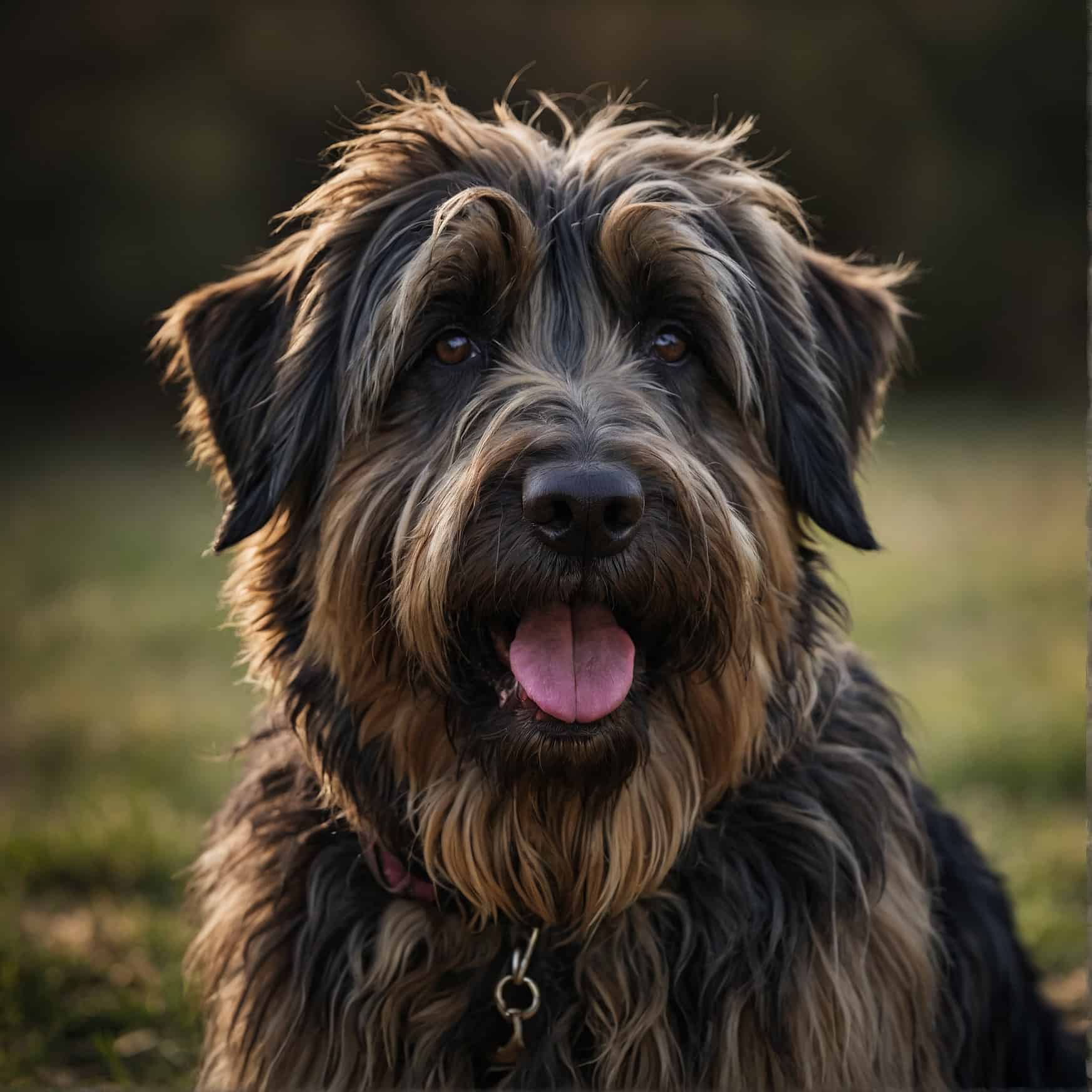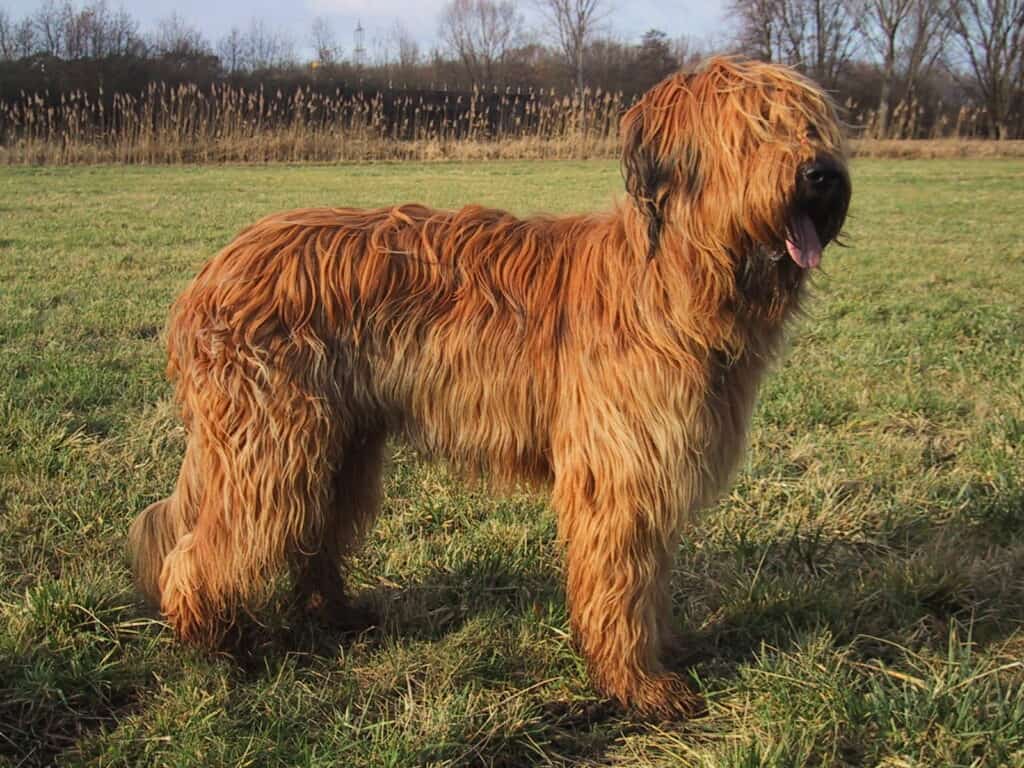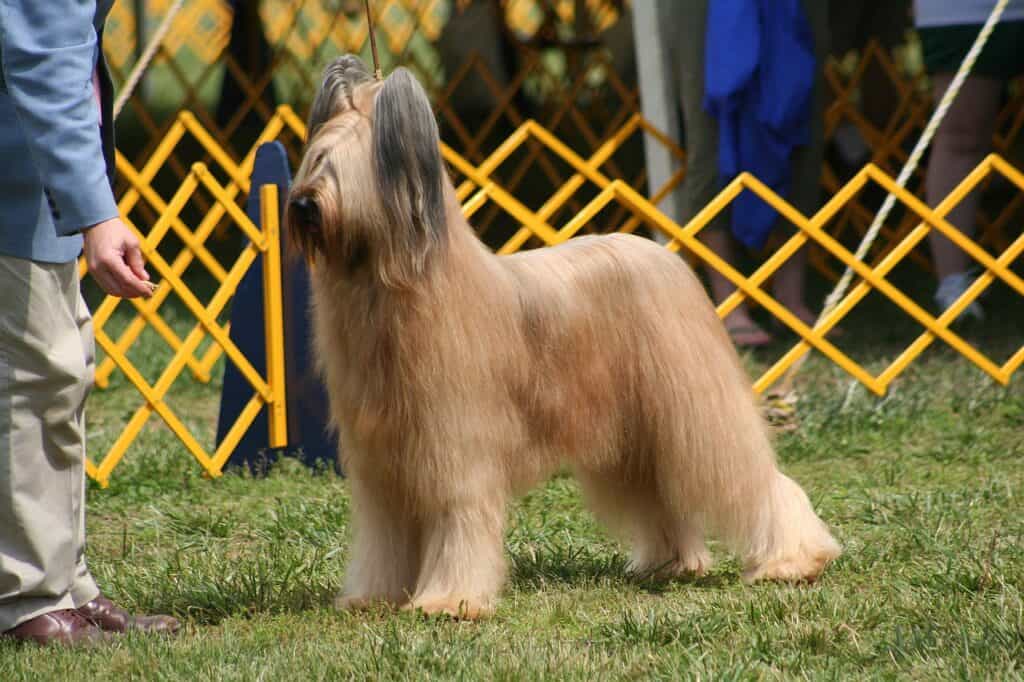The Briard, a symbol of regal elegance, unwavering loyalty, and exceptional herding abilities, has captured the admiration of dog lovers and shepherds. With a history in France, distinctive physical characteristics, and a unique set of personality traits, this breed is celebrated as a reliable and devoted herding and guardian dog.

| Category (Explanation) | Breed Information |
|---|---|
| Year of Breed Conception | Ancient |
| Country of Origin | France |
| Weight (lbs & kg) (Male) | 75-100 lbs (34-45 kg) |
| Weight (lbs & kg) (Female) | 50-65 lbs (23-29.5 kg) |
| Coat Type | Long, double coat |
| Color Variations | Various colors, often black, gray, or tawny |
| Shedding Level (Low, Moderate, High) | Moderate |
| Height (cm & in) | 22-27 inches (56-69 cm) |
| Breed Size | Large |
| Trainability (Low, Moderate, High) | High |
| Mental Needs (Low, Moderate, High) | High |
| Intelligence Level (Low, Moderate, High) | High |
| Energy Level (Low, Moderate, High) | Moderate |
| Agility (Low, Moderate, High) | Moderate |
| Loyalty (Low, Moderate, High) | High |
| Playfulness (Low, Moderate, High) | Moderate |
| Exercise Needs | Regular exercise and mental stimulation |
| Guarding Proficiency (Low, Moderate, High) | High |
| Sociability with Children (Low, Moderate, High) | High |
| Barking Level (Low, Moderate, High) | Low to moderate |
| Digging Tendency (Low, Moderate, High) | Low |
| Destructive Behavior (Low, Moderate, High) | Low |
| Drooling Level (Low, Moderate, High) | Low |
| Obedience Level (Low, Moderate, High) | High |
| Apartment Friendly (Yes/No) | Can adapt to apartment living with sufficient exercise |
| Inherent Prey Drive | Moderate |
| Physical Risk to Others (Low, Moderate, High) | Low |
| Travel Fatality Risk (Low, Moderate, High) | Low |
| Allergen Potential | Low |
| Health Concerns (List of Common Health Concerns) | Hip Dysplasia, Bloat, Eye Issues |
| Average Life Expectancy (Life Expectancy in Years) | 10-12 years |
Woof Mastery is reader supported and our articles may contain affiliate links.
Instead of running third party ads that we have no control of we only use links from high-quality companies we are directly partnered with. Making use of these links come at no cost to you our reader, and in many cases have the extra benefit of discounted rates or sign up bonuses.
If you’re interested you can read more about our affiliate policy here.
We appreciate your support and always insure that the products and services we recommend are high-quality, helpful and relevant to the subject at hand!
The history of the Briard is a tale of loyalty and versatility. These dogs have their origins in France, where they served as herders and protectors of flocks and homes.
Briards are known for their distinctive appearance, including a long, wavy coat and bushy eyebrows. Their loyalty and intelligence made them invaluable in herding and guarding duties.
Over time, Briards have also been recognized for their bravery in various wartime roles. Today, they are cherished for their affectionate nature and as loyal family companions, embodying the spirit of the French countryside.

The Briard’s special qualities lie in its distinctive appearance and gentle nature. These dogs have a history as messenger dogs in wartime, showcasing their bravery and loyalty. Today, they are cherished for their friendly demeanor and versatility as working and family dogs.
Briards have a strong tradition as herding and working dogs in France. Their intelligence, strength, and courage made them excellent herders, guarding and guiding livestock. Their loyalty and protective instincts extended to their families. Today, they continue to participate in herding and dog sports, as well as being cherished family companions, embodying their heritage as dependable working dogs.
Briards have delightful and loving personalities. They are known for their intelligence, loyalty, and herding instincts. These dogs have a history of serving as farm dogs and herding livestock.
Their intelligence and trainability set them apart as dependable workers, and their affectionate nature with their families is evident. Briards are characterized by their charm, devotion, and a sweet disposition, epitomizing the perfect blend of intelligence and affection.
Briards are known for their protective instincts and loyalty. They are affectionate with their families but can be reserved with strangers. Early socialization is essential.
They thrive on mental stimulation and physical activity.
Briards are large-sized dogs with a well-proportioned and robust build. They have a square-shaped head with expressive, dark eyes and long, pendulous ears.
They have a dense, double coat that lies close to their skin. Coat colors can include black, tawny, or gray. Their tail is long and often carried low.
Males typically stand between 23 to 27 inches (58-69 cm) at the shoulder and weigh between 75 to 100 pounds (34-45 kg), while females are slightly smaller and lighter.
Briards have a robust and noble presence, reflecting their history as herding and working dogs.
Briards commonly have a coat in shades of black, tawny, or gray. They may not have distinct coat colors.
Briards often have solid coat colors in black, tawny, or gray without distinct patterns.
Briards have a moderate shedding level. They shed consistently, with more shedding during seasonal transitions. Regular grooming and brushing can help manage shedding and keep their coat in good condition.
Briards have a long, dense, double coat that requires regular grooming to keep it healthy and minimize matting and shedding. Grooming habits for this breed include:
1. Brushing: Regular brushing, at least once or twice a week, is essential to prevent matting and remove loose fur. Use a slicker brush and a pin brush to reach the dense undercoat.
2. Bathing: Bathe Briards when necessary, using a dog-specific shampoo and thorough rinsing.
3. Ears: Check and clean their ears regularly to prevent wax buildup or infections with a veterinarian-recommended ear cleaning solution.
4. Nails: Keep their nails trimmed to a comfortable length to maintain proper gait and prevent discomfort.
5. Teeth: Brush their teeth regularly to ensure dental health and prevent bad breath. Dental chews or toys can be beneficial.
6. Tail and Paw Care: Maintain cleanliness in the tail and paw areas, inspecting for any signs of irritation or injury.
Briards have a high activity level and thrive on both physical and mental challenges. Key points about their activity level include:
1. Exercise Needs: Briards require daily exercise to stay healthy and content. Activities should be engaging and may include walks, playtime, and outdoor adventures.
2. Energy Level: They have a high energy level and enjoy regular exercise to prevent boredom.
3. Herding Heritage: Historically, Briards were bred for herding and protecting livestock. They excel in activities like obedience, agility, and herding trials.
4. Mental Stimulation: In addition to physical activity, mental challenges through training and interactive games are important to keep them mentally sharp.
5. Outdoor Companions: They enjoy outdoor activities and make great companions for hikers and active individuals.
White Swiss Shepherd Dogs, similar to German Shepherds, are highly intelligent and quick learners. Here are some key points about their intelligence:
White Swiss Shepherd Dogs’ intelligence and versatility make them excellent companions and working dogs. Training, socialization, and mental stimulation are crucial for their development and well-being.
Briards are intelligent and need mental stimulation. Engage them in obedience training, herding activities, and interactive games to keep their minds sharp.
Social Interaction: They are social dogs and require regular interaction with their human family. Loneliness can lead to anxiety or destructive behavior, so provide companionship and attention.
Exercise: Mental exercise is equally important. Offer them tasks that challenge their problem-solving skills.
Training and Obedience: Briards benefit from obedience training, herding activities, and mental challenges, which not only stimulate their minds but also strengthen their bond with their owners.
Enter The Woof Mastery

Thinking about a Briard? Keep these considerations in mind:
1. Activity Level: Briards are active and require regular exercise and mental challenges to prevent boredom.
2. Training Needs: They are intelligent and benefit from consistent training and socialization.
3. Space: Briards need space to move, making them better suited for homes with yards.
4. Coat Care: Regular grooming is essential to manage their coat and prevent matting.
5. Herding Instinct: Some Briards may exhibit herding behaviors or tendencies.
Briards, known for their protective nature, may pose a physical risk to others if not properly socialized, trained, or managed. The risk assessment factors include:
1. Protective Instinct: Briards have a strong protective instinct, especially towards their family and territory. Proper training is essential to manage this instinct.
2. Socialization: Early and thorough socialization is crucial to ensure Briards are comfortable around people and other animals. Poor socialization can lead to fear or aggression.
3. Training: Obedience training is essential to teach Briards appropriate behavior and ensure they respond to commands. Well-trained dogs are less likely to engage in aggressive behavior.
4. Owner Responsibility: Responsible ownership involves being aware of the dog’s behavior and taking necessary precautions in public settings.
5. Breed-Specific Legislation (BSL): Briards may not be commonly subject to BSL, but owners should be aware of local regulations.
6. Individual Variability: Each dog is unique, and behavior can vary. Responsible ownership, proper training, and socialization are key to minimizing the potential physical risk to others.
Briards are generally good with children. They are protective, loyal, and can be gentle and patient. Their herding instincts may lead to them trying to gather and watch over kids. Proper socialization and training are essential to ensure positive interactions with children.
Briards are generally capable swimmers. Their robust and well-proportioned physique makes them proficient in the water. Many Briards may enjoy swimming, but it’s important to assess your individual dog’s comfort level and supervise them when they are near water.
Early and positive training will help your Briard puppy become a well-behaved and devoted companion.
Briards are often moderate in terms of noisiness. They may bark when they perceive a need to protect their home or family. While they are alert, they are not excessively vocal.
Briards thrive in homes that provide:
Challenges:
When traveling with Briards, consider the following:
Briards are generally healthy, but they may be prone to certain health concerns, including:
Proper nutrition is crucial for Briards. Follow these nutritional habits:
Proper nutrition is essential for the health and well-being of Briards.
Breed-specific laws (BSL) can impact Briards in certain areas, and owners should be aware of these regulations. BSL is typically enacted at the local level, and the restrictions can vary from one jurisdiction to another. Common types of BSL restrictions that Briards may face include:
The rationale behind BSL is often based on concerns about public safety and perceived risks associated with specific breeds. While Briards are not inherently aggressive, they can be affected by BSL due to their physical resemblance to breeds sometimes included in these laws.
It’s important to note that BSL is a contentious topic, and many advocates argue that it unfairly targets breeds rather than addressing individual dog behavior. They emphasize that responsible ownership, training, and education should be emphasized instead of breed-specific restrictions.
To determine if there are breed-specific laws or restrictions regarding Briards in your area, you should check with your local animal control or government authorities. Be aware of and comply with any local regulations to ensure that you are in compliance with the law while owning a Briard.
Woof Mastery is reader supported and our articles may contain affiliate links.
Instead of running third party ads that we have no control of we only use links from high-quality companies we are directly partnered with. Making use of these links come at no cost to you our reader, and in many cases have the extra benefit of discounted rates or sign up bonuses.
If you’re interested you can read more about our affiliate policy here.
We appreciate your support and always insure that the products and services we recommend are high-quality, helpful and relevant to the subject at hand!
Myth 1: Briards are Aggressive Guard Dogs
Truth: While they can excel in guarding, Briards are not inherently aggressive. They have a gentle and protective nature, making them great family dogs when properly socialized.
Myth 2: They Need Extensive Grooming
Truth: Briards have a long, thick coat, but grooming can be manageable with regular brushing. Their coat does require attention, but they are not overly high-maintenance.
Briards, with their distinctive appearance, have gained recognition in various fields, and some famous examples include:
These Briards have showcased the breed’s elegance and versatility in various roles, from conformation to therapy work and acting.
Briards have been cherished by individuals and families who value their loyalty and protective instincts. While specific historical owners may not be widely known, these dogs have a rich history as herding and working companions.
Briards, like all breeds, face certain challenges and dangers. Some of the greatest dangers and concerns for the breed include:
By understanding these challenges and providing responsible ownership and care, many of these dangers can be mitigated to ensure the well-being of Briards.
The Briard is a French herding breed with origins dating back to the 8th century. Its development involved local herding dogs in the French regions of Brie and Chartrain. Over centuries, selective breeding aimed to create an agile and intelligent herding breed capable of managing large flocks of sheep.
The Briard, known for its loyalty, intelligence, and striking appearance, is a breed that excels as a herding and protection dog. Their affectionate nature and unique coat have earned them a special place in the hearts of dog enthusiasts.
Owning a Briard entails providing mental stimulation, exercise, and regular grooming. Responsible ownership involves addressing potential health concerns and nurturing their protective instincts through training.
With their black, tawny, or gray coats, Briards continue to be cherished for their unwavering loyalty and versatility in both work and companionship.